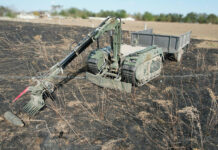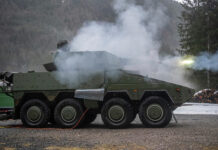FIST (Future Integrated Soldier Technology) is a tri-service project initiated by the UK Ministry of Defense, which will provide the British Armed Forces with an integrated fighting system for dismounted, close combat troops. Initial suits will be available for operational testing by 2007. Under the UK 2 billion pounds program Thales UK will equip 29,000 troops with initial operational capability planned for 2009.
FIST is a modular, integrated, and fully upgradable fighting system which will further integrate with the future FRES combat systems concept of the British army. The system will mesh each soldier into the digitized battlefield as a “weapons system” in his own right, each man-platform contributing to the larger, network enabled environment where each soldier platform becomes a key component within the network centric battlefield system.
FIST will employ enhanced communications capability including voice, data, images and internet facilities. The system will provide adequate bandwidth for the transfer of large volumes of tactical information. Softer camouflage textiles will provide durability, environmental protection and reduced thermal signature while new composite materials provide for lightweight, flexible body armor.
Clothing and protection
FIST will employ enhanced communications capability including voice, data, images and internet facilities. The system will provide adequate bandwidth for the transfer of large volumes of tactical information. Softer camouflage textiles will provide durability, environmental protection and reduced thermal signature while new composite materials provide for lightweight, flexible body armor.
Electronic Equipment
Beside its role as protective gear, the helmet will mount a computerized display which will enable the user to view the weapon’s mounted sight as well as computer generated images. Together with alternative displays such as weapon mounted sights and hand held computers these elements will provide remote viewing of mission critical data including maps, images and video from stored or real-time sources. These remote sources could include weapons sights from other section members, ground sensor pictures sent directly from unattended sensors or from HQ, or surveillance cameras mounted on unmanned aerial or ground vehicles. Night vision technology will be used as part of the FIST system will include advanced versions of Image Intensifier (I2) sights, offering greater sensitivity and clarity combined with reduced size and weight. GPS systems will be combined with a navigation sub-system, including a Digital Compass to provide fully integrated navigation, orientation and target acquisition capability. The soldier will be able to plan a route in advance, incorporating waypoints and avoiding dangers, and follow this even at night, using helmet mounted display with visual or audible cues.
Weapon Systems
The standard issue British Army weapon will be equipped with sights and switches interfacing with the soldier’s suite. It will also receive an underslung grenade launcher which will provide enhanced firepower and use of special munitions. Fire control systems integrated with weapon’s sights are also expected to migrate to the individual weapons. The evolution of small, lightweight, uncooled thermal sights will provide dismounted troops the ability to engage targets covertly at night and through smoke. In addition, the incorporation of Rapid Area effects with precision fire control will enable the infantry team to deliver effects much more accurately than current systems.
Development and testing
In January 2005 the FIST system went through its first major experimental trial. Part of the Assessment Phase, this is the latest of a series of trials that will assess the requirements for the FIST system and identify the factors that will influence the next phase. The trials took place at the Army’s Salisbury Plain Training Area and involved some 70 soldiers from 2nd Battalion The Princess of Wales’s Royal Regiment, representing the organizational structure of an infantry company. The soldiers were put through a number of scenarios, typical of those encountered by infantry soldiers, including a night patrol, rural defense and urban assault. Their effectiveness was compared with that of other soldiers equipped with conventional infantry equipment.
Each soldier was equipped with experimental FIST systems, comprising a combination of “Off The Shelf” modules, including radios, computers, GPS, weapon sights and cameras. The equipment was linked together to form an integrated soldier system. These experimental systems are designed to answer a series of questions concerning the functionality required by individual members of the infantry section, such as riflemen and commanders, in particular relating to their information needs during operations. The resulting data will support the FIST V2 system design, which will be a further step toward the final FIST system that ultimately enters service. V2 will be optimized for weight, power consumption, human factors, cost and reliability and will be the subject of a major trial in the second half of 2005.
At a briefing at DSEi 2005, Thales indicated the program is on time and budget to proceed to the next phase of validation testing in October 2005. In the development and evaluation process Thales and the Defense Procurement Agency conducted some 50 equipment mini-trials have, as part of the system functionality testing and risk reduction process.
While FIST improves the full capability of the infantry warrior, the greatest enhancement of capability will come from the introduction of command, control, communications, computers and intelligence (C4I) tools to the section level. Systems such as situational awareness system are not expected to be available to all section members, but mainly to the commanders and leaders. At present, the section’s elements will include commander, grenadier, gunner and marksman – each role will be provided for by a variation of the FIST design. FIST suits will retain the current SA-80 A2 assault rifle. This weapon is already equipped with an optical sight and will add 40mm grenade launcher for the grenadier.












